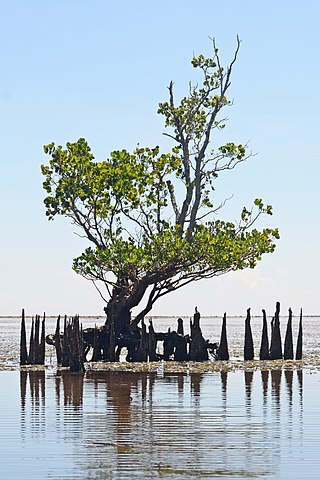
A mangrove is a shrub or tree that grows mainly in coastal saline or brackish water. Mangroves grow in an equatorial climate, typically along coastlines and tidal rivers. They have special adaptations to take in extra oxygen and to remove salt, which allow them to tolerate conditions that would kill most plants. The term is also used for tropical coastal vegetation consisting of such species. Mangroves are taxonomically diverse, as a result of convergent evolution in several plant families. They occur worldwide in the tropics and subtropics and even some temperate coastal areas, mainly between latitudes 30° N and 30° S, with the greatest mangrove area within 5° of the equator. Mangrove plant families first appeared during the Late Cretaceous to Paleocene epochs, and became widely distributed in part due to the movement of tectonic plates. The oldest known fossils of mangrove palm date to 75 million years ago.

Versova is an upmarket neighbourhood in north-western Mumbai. It is known for its beach and the Versova Fort. The beach of Versova undertook a massive clean-up effort in 2016, labelled as the largest ever beach clean-up.

Mahim Bay is a picturesque bay situated in the Arabian Sea, along the western coast of India. It is located in the southern part of Mumbai, the capital city of the Indian state of Maharashtra. The bay was named after the islands of Mahim and Salsette were merged in the early 19th century. The Mithi River drains into Mahim Creek which drains into the Bay, and forms the border between the Mumbai city and its Suburbs.

Marine ecosystems are the largest of Earth's aquatic ecosystems and exist in waters that have a high salt content. These systems contrast with freshwater ecosystems, which have a lower salt content. Marine waters cover more than 70% of the surface of the Earth and account for more than 97% of Earth's water supply and 90% of habitable space on Earth. Seawater has an average salinity of 35 parts per thousand of water. Actual salinity varies among different marine ecosystems. Marine ecosystems can be divided into many zones depending upon water depth and shoreline features. The oceanic zone is the vast open part of the ocean where animals such as whales, sharks, and tuna live. The benthic zone consists of substrates below water where many invertebrates live. The intertidal zone is the area between high and low tides. Other near-shore (neritic) zones can include mudflats, seagrass meadows, mangroves, rocky intertidal systems, salt marshes, coral reefs, lagoons. In the deep water, hydrothermal vents may occur where chemosynthetic sulfur bacteria form the base of the food web.

Cone snails, or cones, are highly venomous sea snails of the family Conidae.

Amphibola is a genus of small, air-breathing terrestrial or semi-marine snails with an operculum, pulmonate gastropod molluscs in the family Amphibolidae.
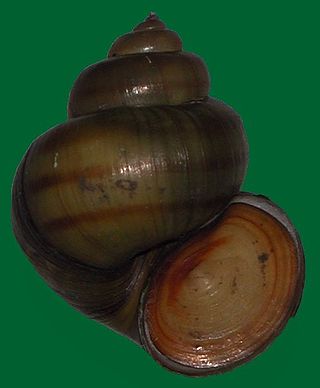
Viviparidae, sometimes known as the river snails or mystery snails, are a family of large aquatic gastropod mollusks, being some of the most widely distributed operculate freshwater snails.
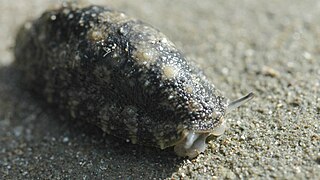
Onchidiidae are a family of small, air-breathing sea slugs. They are shell-less marine pulmonate gastropod molluscs. Onchidiidae is the only family within the superfamily Onchidioidea.

Thalassina is a genus of mud lobsters found in the mangrove swamps of the Indian Ocean and western Pacific Ocean. Its nocturnal burrowing is important for the recycling of nutrients in the mangrove ecosystem, although it is sometimes considered a pest of fish and prawn farms.

Euglandina is a genus of predatory medium- to large-sized, air-breathing, land snails, terrestrial pulmonate gastropod mollusks in the family Spiraxidae.

Achatina achatina, commonly known as the giant African snail, also known as the giant tiger land snail is a species of large, air-breathing land snail, a terrestrial pulmonate gastropod mollusk in the family Achatinidae. The name "Achatina" is from "achates", Greek for agate. It shares the common name "giant African snail" with other species of snails such as Lissachatina fulica and Archachatina marginata.
Phallomedusa solida is a species of small, air-breathing land snail with an operculum, a pulmonate gastropod mollusc in the family Phallomedusidae.

Salinator is a genus of small, air-breathing, terrestrial or semi-marine snails with an operculum, pulmonate gastropod molluscs in the subfamily Salinatorinae of the family Amphibolidae.

Mariaella dussumieri is a species of air-breathing land slug, a terrestrial pulmonate gastropod mollusk in the family Ariophantidae.
Global mangrove distributions have fluctuated throughout human and geological history. The area covered by mangroves is influenced by a complex interaction between land position, rainfall hydrology, sea level, sedimentation, subsidence, storms and pest-predator relationships). In the last 50 years, human activities have strongly affected mangrove distributions, resulting in declines or expansions of worldwide mangrove area. Mangroves provide several important ecological services including coastal stabilization, juvenile fish habitats, and the filtration of sediment and nutrients). Mangrove loss has important implications for coastal ecological systems and human communities are dependent on healthy mangrove ecosystems. This article presents an overview of global mangrove forest biome trends in mangrove ecoregions distribution, as well as the cause of such changes.
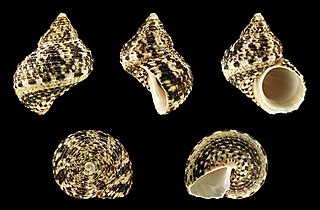
Turbo bruneus, common name the brown (Pacific) dwarf turban or the little burnt turbo, is a species of sea snail, marine gastropod mollusk in the family Turbinidae. These snails are called "turbo" because they can move quite quickly for a snail, using a muscular foot to glide along the ocean floor. They feed on algae and other small organisms that they scrape off rocks and other surfaces.

Terebralia palustris, common name the giant mangrove whelk, is a species of brackish-water snail, a gastropod mollusk in the family Potamididae. This tropical species which inhabits mangrove environments of the Indo-West Pacific region, has the widest geographic distribution amongst the potamidids extending from eastern Africa to northern Australia. Terebralia palustris is the largest mangrove gastropod, with a maximum shell length of 190 mm recorded from Arnhem Land, Australia.

Indoplanorbis is a genus of air-breathing freshwater snail. Its only member species is Indoplanorbis exustus, an aquatic pulmonate gastropod mollusk in the family Planorbidae, the ram's horn snails. The species is widely distributed across the tropics. It serves as an important intermediate host for several trematode parasites. The invasive nature and ecological tolerance of Indoplanorbis exustus add to its importance in veterinary and medical science.
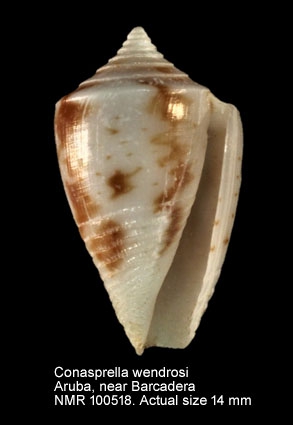
Conasprella wendrosi is a species of sea snail, a marine gastropod mollusk in the family Conidae, the cone snails and their allies.
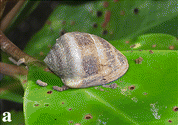
Cassidula nucleus is a species of air-breathing marine snail, a pulmonate gastropod mollusk in the family Ellobiidae.


















